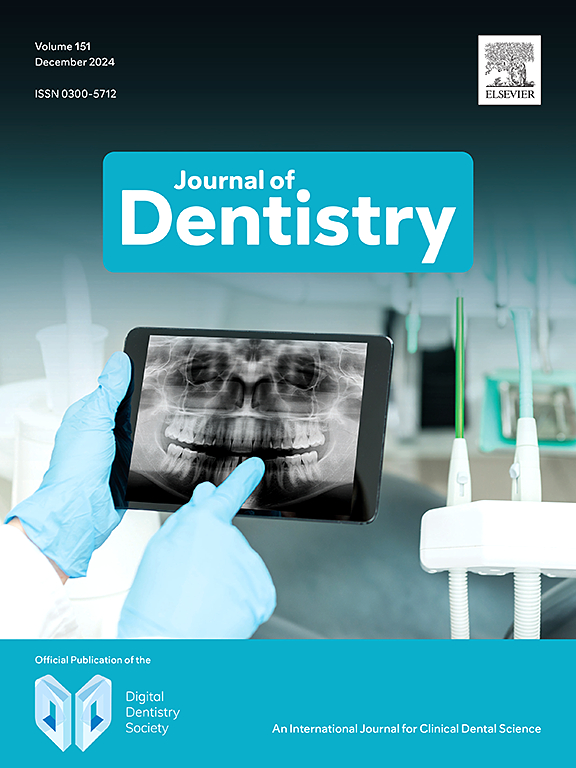牙齿脱落解释了痴呆症患者的收入不平等。
IF 4.8
2区 医学
Q1 DENTISTRY, ORAL SURGERY & MEDICINE
引用次数: 0
摘要
目的:世界范围内存在口腔健康和痴呆方面的社会经济不平等。本研究探讨了牙齿脱落在收入与痴呆之间的中介作用。方法:本研究采用日本老年学评价研究的数据,研究对象为年龄≥65岁的人群。解释变量是2010年的等效收入。结果变量是2010年至2022年间的痴呆发病率。Cox比例风险回归用于检查收入与痴呆发病率之间的关系,并对混杂因素进行了调整。我们进行了因果中介分析,以评估天然牙齿的数量在多大程度上介导了这种关联。结果:在21,306名参与者中,平均年龄为73.4岁,53.5%为女性。老年痴呆症的累积发病率在高收入人群中为19.7%,在低收入人群中为24.0%。收入较低的人牙齿较少(牙齿≥20颗的患病率:高收入人群占42.2%,低收入人群占31.1%)。调整混杂因素后,低收入与痴呆相关(风险比[95%可信区间[CI]: 1.18 [1.10;1.26]),通过控制牙齿数量可以部分减弱(相对危险度[95% CI]: 1.17 [1.09;1.25])。因果中介分析表明,牙数介导的比例为6.6%。结论:我们的研究发现,牙齿脱落部分介导了收入与痴呆之间的关联。预防牙齿脱落似乎可以减少老年人痴呆症的不平等现象。临床意义:牙齿脱落在收入与痴呆的关系中起中介作用。维持天然牙齿的策略似乎在减少痴呆症的社会经济不平等方面有效。本文章由计算机程序翻译,如有差异,请以英文原文为准。
Tooth loss explains income inequalities in dementia
Objectives
Socioeconomic inequalities in oral health and dementia exist worldwide. This study investigated the mediating effects of tooth loss on the association between income and dementia.
Methods
This study used data from the Japan Gerontological Evaluation Study, which targeted people aged ≥65 years. The explanatory variable was equivalent income in 2010. The outcome variable was dementia incidence between 2010 and 2022. Cox proportional hazard regression was used to examine the association between income and dementia incidence, adjusting for confounders. We performed causal mediation analyses to evaluate the extent to which the number of natural teeth mediates the association.
Results
Among the 21,306 participants, the mean age was 73.4 years, and 53.5 % were females. The cumulative incidence of dementia was 19.7 % for people with higher incomes and 24.0 % for those with lower incomes. People with lower incomes had fewer teeth (the prevalence of having ≥20 teeth: 42.2 % in higher incomes and 31.1 % in lower incomes). Lower income was associated with dementia after adjusting for confounders (Hazard ratio (HR) [95 % confidence interval (CI)]: 1.18 [1.10; 1.26]), which was partially attenuated by controlling for the number of teeth (HR [95 % CI]: 1.17 [1.09; 1.25]). Causal mediation analysis demonstrated that the proportion mediated by the number of teeth was 6.6 %.
Conclusions
Our study found that tooth loss partially mediated the association between income and dementia. Preventing tooth loss appears to reduce inequalities in dementia among older people.
Clinical significance
Tooth loss has mediating effects on the association between income and dementia. Strategies for maintaining natural teeth seem effective in reducing the socioeconomic inequalities of dementia.
求助全文
通过发布文献求助,成功后即可免费获取论文全文。
去求助
来源期刊

Journal of dentistry
医学-牙科与口腔外科
CiteScore
7.30
自引率
11.40%
发文量
349
审稿时长
35 days
期刊介绍:
The Journal of Dentistry has an open access mirror journal The Journal of Dentistry: X, sharing the same aims and scope, editorial team, submission system and rigorous peer review.
The Journal of Dentistry is the leading international dental journal within the field of Restorative Dentistry. Placing an emphasis on publishing novel and high-quality research papers, the Journal aims to influence the practice of dentistry at clinician, research, industry and policy-maker level on an international basis.
Topics covered include the management of dental disease, periodontology, endodontology, operative dentistry, fixed and removable prosthodontics, dental biomaterials science, long-term clinical trials including epidemiology and oral health, technology transfer of new scientific instrumentation or procedures, as well as clinically relevant oral biology and translational research.
The Journal of Dentistry will publish original scientific research papers including short communications. It is also interested in publishing review articles and leaders in themed areas which will be linked to new scientific research. Conference proceedings are also welcome and expressions of interest should be communicated to the Editor.
 求助内容:
求助内容: 应助结果提醒方式:
应助结果提醒方式:


